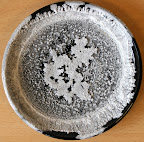Another type of paper we looked at was a special 'absorbent' paper called filter paper or blotting paper. When we looked at it using the microscope, we noticed that the fibres were tangled and there were little spaces between them. Blotting paper is used for soaking up liquid (a bit like paper towels). The liquid gets trapped in the spaces between the fibres.
Just for fun (after all, if you can't do things 'just for fun' on your birthday, when can you?) we decided to use our blotting paper to take a closer look at black.
First we asked ourselves 'What is black?'
Here are some of our thoughts:
It's a colour
It's dark
It is the darkest colour
It's the opposite of white
You could mix all the dark colours to make black
Next we wondered, 'Are all blacks the same?' Is black black?
We decided that:
Some blacks can be darker than others but that really, black is just black.....
Here's what we did to learn a bit more about black.
1) We collected some different black markers
2) We cut four or five narrow strips of blotting paper
3) We drew a splodge of black from each marker near one end of each strip
4) We carefully hung the strips over the edge of a plastic beaker
5) We poured water into the beaker so that it just touched the bottom of the blotting paper but not the splodge of black
6) We waited to see what would happen.....
Almost immediately, we noticed the water creeping upwards, towards the splodges of black. Then something strange happened; as the water reached the splodges of black we started being able to see different colours that must have been hiding there.....
We compared the colours that we saw in the different markers.
We found purple, pink , brown, orange , yellow and blue hiding in our different black markers!

Remember our original question.....Black is black.....or is it? Well, is it?
Oh dear.....that had got us started.
We remembered that the primary colours are red, yellow and blue and that all other colours can be made using them; for example, purple can be made from red and blue.....and we wondered if it is the same when colour for markers is made.....
Would we see only red in a red marker? Would a purple marker have red and blue hidden inside it?
Why don't you have a go at a similar inveSTIGation and see what you discover?




